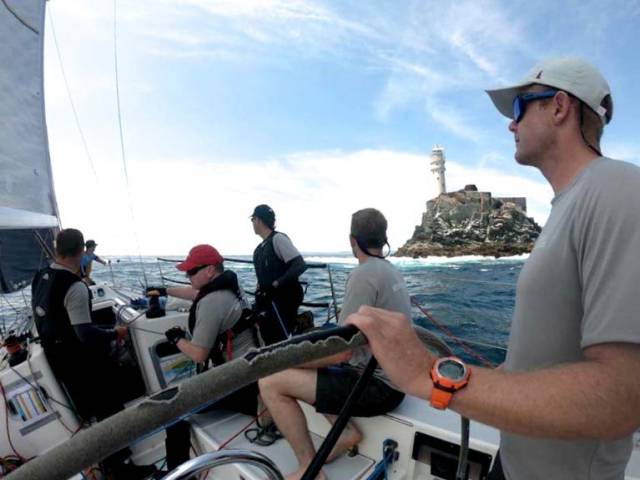Time was when “A Soldier’s Wind” was a slightly patronising term used to describe exceptionally favourable conditions for smooth voyaging in the great days of sail, with a beam reach in a good Force 4 being held up as the ideal writes W M Nixon
It dated from the era of government troopships criss-crossing the globe under sail when empire-building was in fashion, sailed by naval crews detailed with the job of getting military task-forces to operational hotspots as smoothly and quickly as possible.
It’s a term you’ll hear rarely used these days, if at all, as the growing need for troopships coincided with the arrival of steam- powered vessels which, while they were far from being luxury liners, were more efficient than sailing ships in this role.
So “A Soldier’s Wind” has been largely consigned to history and vague memory. And its disappearance from the Irish maritime vocabulary has been hastened by some remarkable sailing soldiers led by the likes of Commandant Barry Byrne, who has given us an entirely new perspective on military prowess in top flight racing boats.
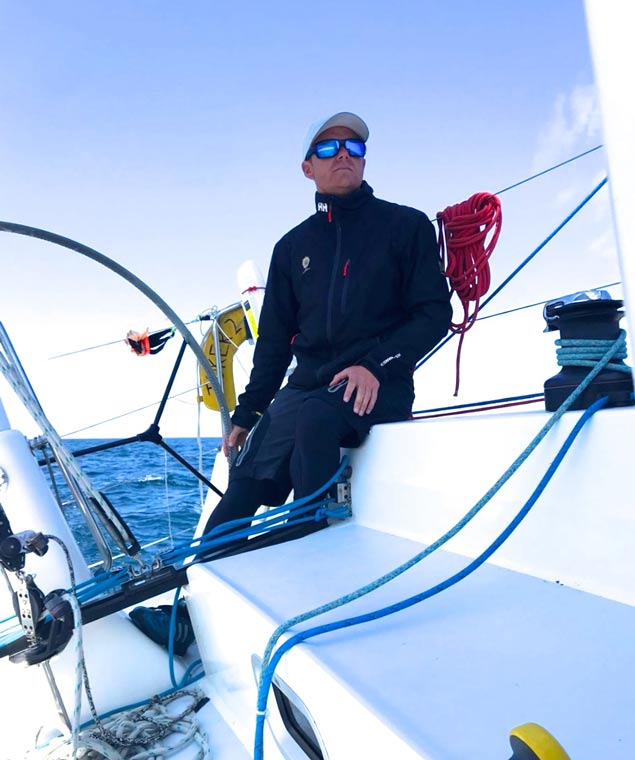 Barry Byrne at Joker II’s helm on Thursday July 5th, approaching the finish line at Wicklow to take second overall in the Round Ireland 2018, and clear first in the Services Division
Barry Byrne at Joker II’s helm on Thursday July 5th, approaching the finish line at Wicklow to take second overall in the Round Ireland 2018, and clear first in the Services Division
But although Barry Byrne has moved this military seafaring on to a new level of active involvement and command, Irish soldiers going in for offshore racing is nothing new. Way back in 1995, we did the Dun Laoghaire to Dingle Race with our hefty Contessa 35, and after a ding-dong nearly all the way with Jim Donegan of Cork with his Hustler 36 White Rooster (which he won, but we beat him the following year in the Round Ireland), we found ourselves berthed for one of the few times time alongside Dens Doyle’s mighty Frers 51 Moonduster, which had taken line honours and in time was the overall winner too.
It was intriguing to find Moonduster – which could carry a racing complement of up to 15 - was being crewed to a significant level by Army Cadets. One of Denis’s many sailing friends was the Irish army’s Colonel Barney Goulding. Having seen that Naval Cadets from the nearby base at Haulbowline in Cork Harbour did not necessarily work out when invited to join Moonduster’s enormous panel as potential crewmembers because they came aboard with too many pre-conceived ideas as to how a boat should be sailed and run, Barney suggested that he be allowed to give a squad of Army cadets a try.
It worked out very well at a high level of mutual respect, as the young army people were accustomed to working as a close team, they were extremely fit, and they were keen to learn while not claiming any deep knowledge of sailing. As for Denis, he just liked to get things done as quickly as possible with a minimum of fuss, and he was a main with absolutely no highfalutin airs or graces.
And the system worked very well indeed at a racing level– the convincing performance by Moonduster every which way in the Dingle Race proved it. At the time, many defence forces worldwide had long used sailing - particularly offshore sailing – as a useful adjunct to their training programme, often with a fleet of Navy-owned yachts to provide it. But in Ireland, as ever, we were to come to it in our own individualistic way.
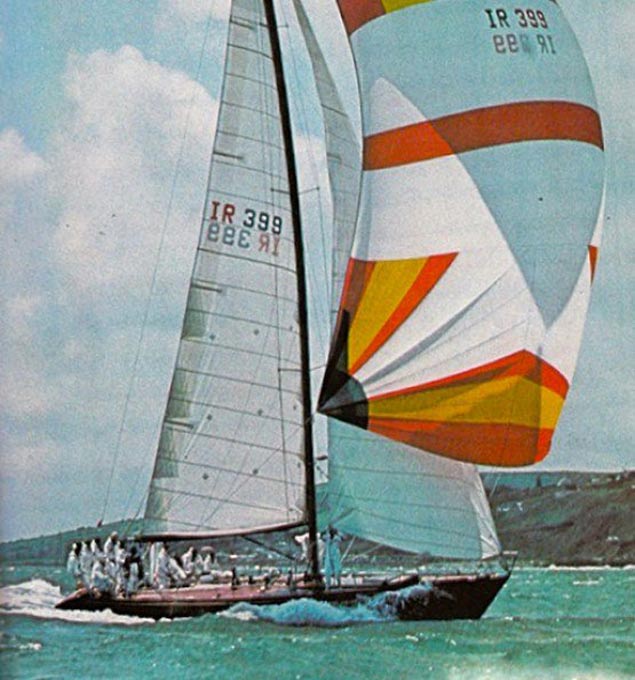 Denis Doyle’s Moonduster, brand new out of Crosshaven Boatyard in 1981. At first her large crew panel of 30 was mostly made up with Crosshaven sailors, but as they acquired boats of their own and fleet numbers grew generally, Moonduster used other sources including enthusiastic Army cadets to build fresh crews. Photo: W M Nixon
Denis Doyle’s Moonduster, brand new out of Crosshaven Boatyard in 1981. At first her large crew panel of 30 was mostly made up with Crosshaven sailors, but as they acquired boats of their own and fleet numbers grew generally, Moonduster used other sources including enthusiastic Army cadets to build fresh crews. Photo: W M Nixon
The Naval Service has a Yacht Squadron with its marina for officially-owned and private boats at their headquarters base at Haulbowline in Cork Harbour race, and sea training in craft of all sizes has been encouraged. But it all suddenly moved on to a new level in February 2016 when then Minister for Defence Simon Coveney suggested – or rather, gave firm instructions – that there should be an Inter-Services Challenge within the up-coming Volvo Cork Week 2016 in five months time.
It fell to a noted sailing soldier, Barry Byrne who originally emerged from that noted sailing nursery of Wicklow, to put together the structure of what became the Inter-Services Beaufort Cup, with a substantial entry and each boat (people were generous in making competitive craft available) carrying a crew which was made up of at least 50% services personnel, but in most cases the proportion was much higher than that.
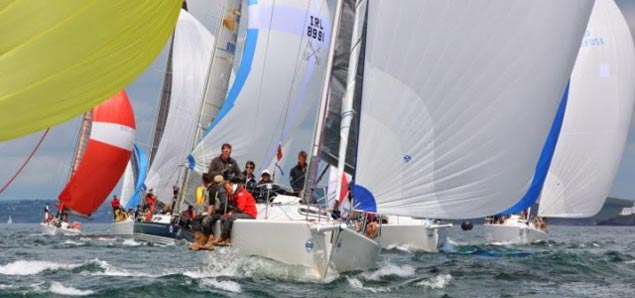 Racing under way for the inaugural Beaufort Cup Series, Volvo Cork Week 2016. Photo Robert Bateman
Racing under way for the inaugural Beaufort Cup Series, Volvo Cork Week 2016. Photo Robert Bateman
With a programme which included a separate race around the Fastnet yet also somehow incorporated the Beaufort Cup Series as part of Volvo Cork Week, its success exceeded all expectations, and the Irish Defence Forces Crew sailing the J/109 Joker II loaned by John Maybury of the Royal Irish YC on Dublin Bay, and skippered by Commandant Barry Byrne, had a popular overall win.
Suddenly, sailing was the hot ticket in military training thinking. Or so sailing enthusiasts liked to think. Certainly, we waited with some hopeful expectation to see what the powers-that-be might allow Barry Byrne to do next for the development of our sport in the broader context.
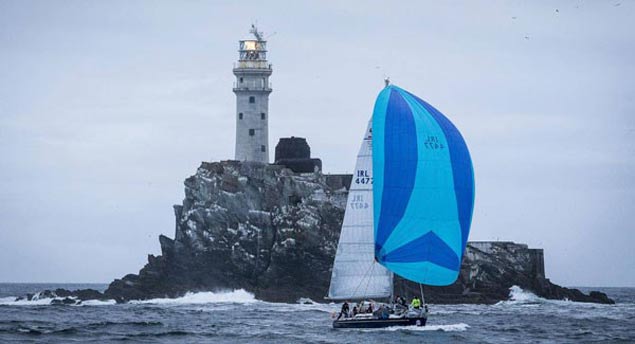 With the Fastnet Rock as the turning point for its offshore race, the Beaufort Cup added a new dimension to Cork Week
With the Fastnet Rock as the turning point for its offshore race, the Beaufort Cup added a new dimension to Cork Week
But the Army has a way of bringing everybody back to earth to remind us of its real purpose in life. Very quickly, the next item in the Barry Byrne military career was a six month tour of duty with the Irish contingent in the UN Peace-Keeping Forces in South Lebanon, based on the South West Headquarters as Deputy Director of the Tactical Operations Sector. Essential soldiering perhaps, but there’s not a lot of room for the development of sailing as an adjunct to military training in a dusty posting like that.
However, as all sailing now knows, Barry Byrne is very much back on the home scene again, with input to the second annual staging of the Beaufort Cup in Volvo Cork Week starting on Sunday July 15th. And meanwhile – also with Joker II – he and his Defence Forces crew have just had a magnificent Volvo Round Ireland Race, second overall and runaway winners of the Services Division.
But whether or not they’re going to be able to continue their run of success into the Beaufort Cup 2018 is another matter, for it has moved up several notches to become the glamour event of Cork Week, and there’s every indication that some crews will make full use of the rule that only 50% of their number be from the Service they represent.
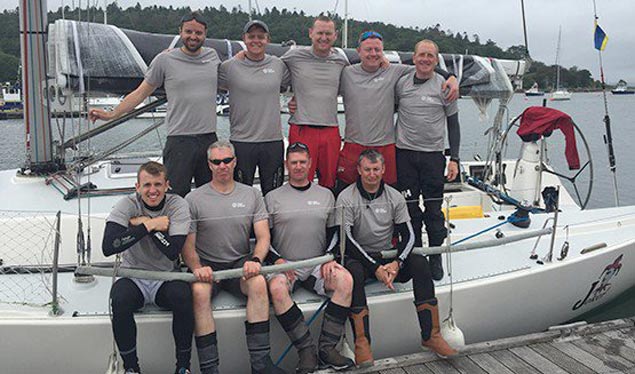 The winning Beaufort Cup crew, July 2016 – Barry Byrne second left, top.
The winning Beaufort Cup crew, July 2016 – Barry Byrne second left, top.
Even Barry Byrne himself is having to resort to some civilian support as one of his round Ireland crew sustained three fractured ribs during that sometimes decidedly rugged race, and while the casualty heroically carried on after being strapped up by his shipmates, doctor’s orders prohibit him from the demands of the Beaufort Cup.
So Joker II’s crew for this series is: Comdt. Barry Byrne, Sgt. Paddy McGrath, Lt Marcus Ryan, Lt Col Wayne Tyrell, Lt. Richie O’Hagan, Comdt. (Retd.) Ian Travers, Cpl. (Retd.) Brian Phelan, Brian Byrne, Malcolm Moir and Louis Malloy.
There are several in this lineup who shared in the success of 2016, but for 2018 there are 16 other high-powered entries for the Beaufort Cup determined to knock Joker II off her perch. They’re all seriously competitive craft, and with no less than eight J/109s in the Beaufort lineup, and with people of the calibre of Nin O’Leary, Tim Goodbody, Andrew Algeo, and Olympic coach Rory Fitzpatrick in various crew lineups, it could be anybody’s game.
Simon Coveney himself may now be Ireland’s Foreign Minister, but he’s no slouch on the sailing race course when he can find time to get afloat, and his name is associated with the Irish National Sailing Schools’ J/109 Jedi entry for the Beaufort Cup, while another name of note is solo sailor Joan Mulloy of Westport, whose Figaro 23 will be fully crewed up for this event.
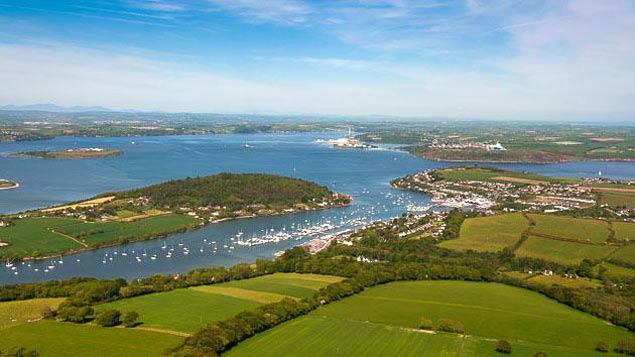 Historic and hospitable sailing paradise – looking northeast over Crosshaven and Cork Harbour
Historic and hospitable sailing paradise – looking northeast over Crosshaven and Cork Harbour
With the PSNI and Atlantic Youth Trust among those entered, the breadth of the competition is clearly in evidence as we also have crews from the Centenary-celebrating Royal Air Force, the Royal Navy, and the British Army’s Royal Engineers and Royal Signals, with a J/109 and an Elan 344 respectively.
Their programme will be stamina-testing afloat and ashore, as it includes that race round the Fastnet, following which there’s a Gala Dinner at Naval HQ in Haulbowline, and then they’ve somehow to find the energy to throw themselves into the concluding days of Volvo Cork Week itself, which will find Crosshaven humming.
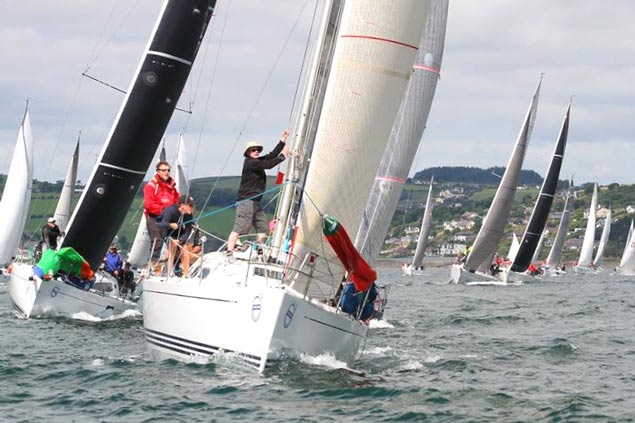 The magic moment of being first at the weather mark is even better in Volvo Cork Week.
The magic moment of being first at the weather mark is even better in Volvo Cork Week.
The Royal Cork Yacht Club sits comfortably in its role of the world’s senior yacht club approaching its Tricentenary, while at the same time being in harmony with its neighbourhood and community. This was much in evidence on the charming evening recently (it was appropriately Midsummmer’s Night) when international designer Ron Holland launched his memoirs, and explained how he first came to Crosshaven for a weekend in November 1973 to look into an enquiry from Hugh Coveney and sailmaker John McWilliam about a new boat design, and ended up staying in Ireland for forty years and building a global business.
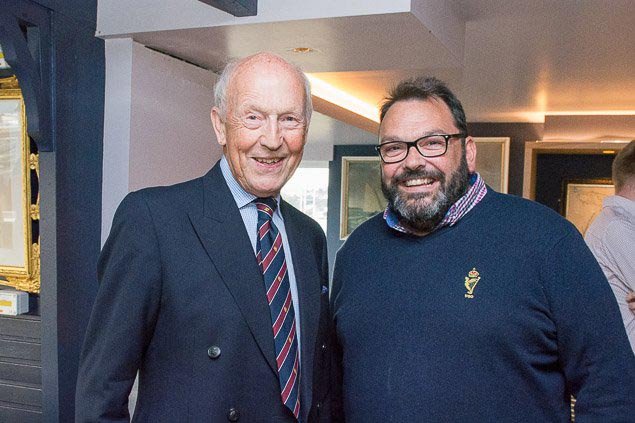 Crosshaven sailmaking pioneer Johnny McWilliam and RCYC Vice Admiral Colin Morehead. Photo Robert Bateman
Crosshaven sailmaking pioneer Johnny McWilliam and RCYC Vice Admiral Colin Morehead. Photo Robert Bateman
What with video presentations and personal memories in front of an audience of all ages, it could have been chaotic, but with Johnny McWilliam as MC and the RCYC’s CEO Gavin Deane in his usual efficient, unflappable, and obliging style, it was a historic evening of remarkable and entertaining memories which told us as much about the spirit of the Royal Cork as anything else.
Thus they take Volvo Cork Week in their stride, with Organising Committee Chairman Kieran O’Connell – he has been in the post since 2014 – knowing its complete workings inside and out, which is no easy achievement. For the expectations for Cork Week come laden with history, and the business of melding the Beaufort Cup and class championships for boats like the International Dragons, the SB20s and the 1720s into one big successful event doesn’t happen without special effort.
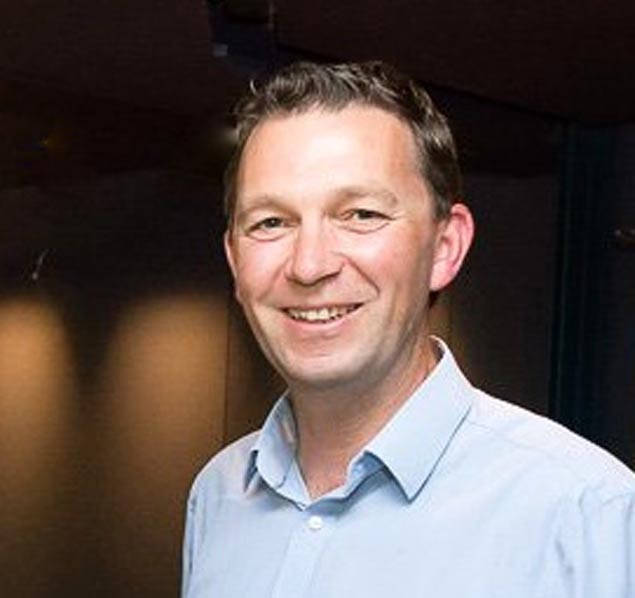 Gavin Deane, CEO Royal Cork YC. Photo: Robert Bateman
Gavin Deane, CEO Royal Cork YC. Photo: Robert Bateman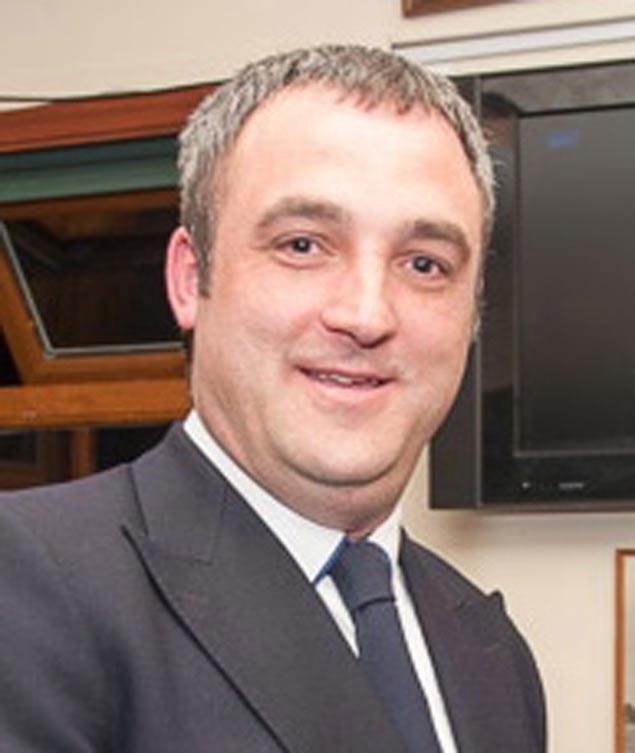 Kieran O’Connell, Chairman of Cork Week Organising Committee. Photo: Robert Bateman
Kieran O’Connell, Chairman of Cork Week Organising Committee. Photo: Robert Bateman
Cork Week as we know it goes back to 1978, when it was inaugurated by the then RCYC Admiral Archie O’Leary, who felt he could significantly improve on an ISORA Week which had been staged at Crosshaven in 1976, while there were also memories of a small-fleet mini-week in 1970 as part of the RCYC Quarter Millennial Celebrations, with the overall winner being Jack McKeown’s S&S 34 Korsar from the Royal St George YC in Dun Laoghaire.
But as the massive History of the Royal Cork Yacht Club published in 2005 confirmed, extended regattas often using coastal courses to take in Kinsale dated back to at least 1859, and the still-very-much-alive pure silver “Kinsale Kettle” trophy of that year is ample evidence of this. Yet while the distant history is there and must be respected, the continuing refinement of the programme with new ideas in Cork, and taking aboard ideas from the success of others, is a useful way to go.
For until now this has arguably been the best season for many years for regattas in Ireland, a reminder of what we can do when the weather is obliging. The endless sunshine and drought may be a very real problem ashore, with the nation rendered somnolent to the point of being comatose. But people are energised afloat in a summer which until this weekend last saw rain – and not much of it – on the first day of the Wave Regatta at Howth at the beginning of June. And that was followed by two days of so much sun that it obliterated any grey day memories, and set the pattern for the East Coast regattas.
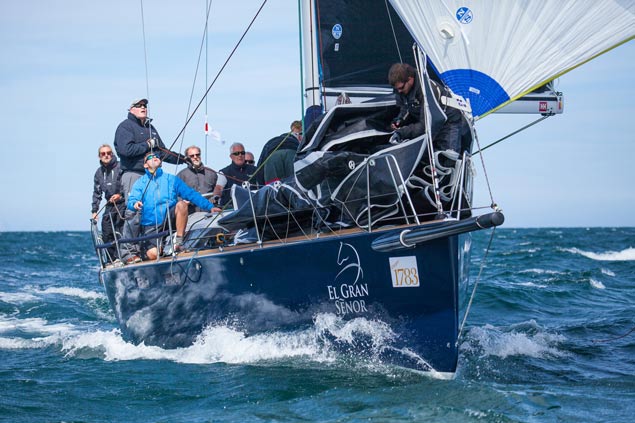 Is that hull black, or is it midnight blue? Either way, Scottish skipper Jonathan Anderson’s J/122E El Gran Senor got the better of Jamie McWilliam’s Ker 40 Signal 8 at last weekend’s Bangor Town Regatta on Belfast Lough, and is now on her way to Volvo Cork Week. Photo: Andrew Gallagher
Is that hull black, or is it midnight blue? Either way, Scottish skipper Jonathan Anderson’s J/122E El Gran Senor got the better of Jamie McWilliam’s Ker 40 Signal 8 at last weekend’s Bangor Town Regatta on Belfast Lough, and is now on her way to Volvo Cork Week. Photo: Andrew Gallagher
As the land continued to dry, the sea breezes behaved in sunny textbook style to give great sailing which could be brought to a close at the proper time for the shoreside festivities to get under way, and last weekend saw this happening in the one day Royal St George YC Regatta on Dublin Bay, and the three day Bangor Town Regatta on Belfast Lough hosted by Ballyholme YC and Royal Ulster YC.
Leading boats from both events have headed on for Cork, and noted podium craft from Bangor include veteran Scottish skipper Jonathan Anderson’s J/122E El Gran Senor which seems to be all black – sails and everything – and managed to win Class 0 against Jamie McWilliam’s Ker 40 Signal 8 on Belfast Lough, where another class winner was Rory Fekkes slippy little all black F’nGr8. She’s also due to take to the line in Cork, as will Jay Colville’s successful First 40 Forty Licks from Strangford Lough.
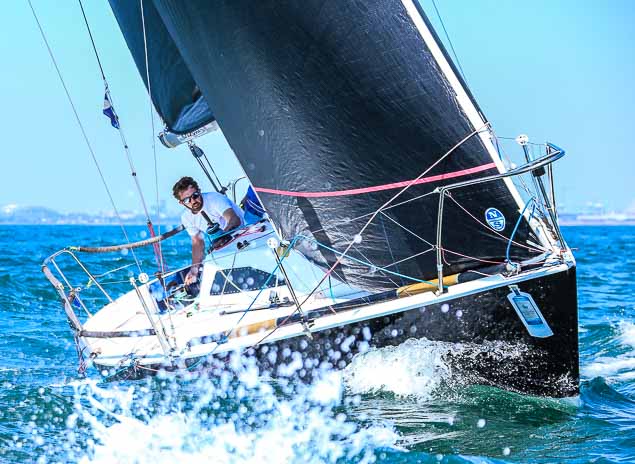 Johnny Swann’s classic Half Tonner Harmony Photo: Afloat.ie
Johnny Swann’s classic Half Tonner Harmony Photo: Afloat.ie
From further down the East Coast, Johnny Swann’s classic timber-built Half Tonner Harmony out of Howth is also stepping up to the Crosshaven plate, while the West Coast – in addition to Joan Mulloy from Westport – has the ever-keen Liam Burke from Galway with the Farr 31 Tribal, and French interest is provided by Jean Francois Nouel from Pornic in Brittany with his Sun Fast 3200 Hakuna Matata, which at one stage was in the top three in last week’s Round Ireland, but had slipped by the finish.
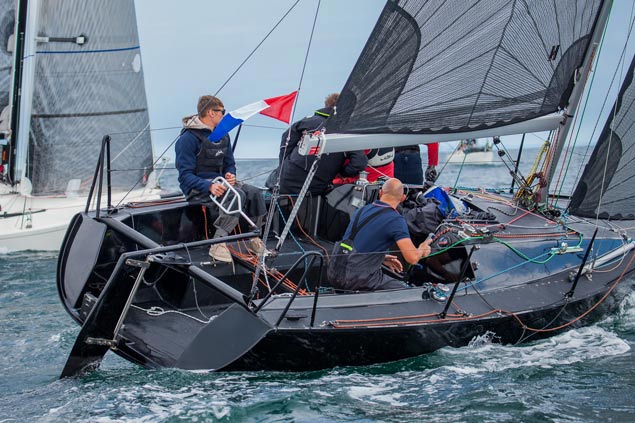 Rory Fekkes’ little black flyer Fn’Gr8 from Carrickfergus was once upon a time a sedate little Beneteau. Photo: Andrew Gallagher
Rory Fekkes’ little black flyer Fn’Gr8 from Carrickfergus was once upon a time a sedate little Beneteau. Photo: Andrew Gallagher
Another noted visitor is the J/109 Mojito from Pwllheli (Vicky Cox & Peter Dunlop), the 2017 ISORA Champion. She’ll be racing against an interesting turnout of J/109s, for when the eight boats of this popular type in the Beaufort Cup are added to the others in the Open Division, we’ve a round dozen of well-tuned J/109s waiting to do battle.
There’s also a dozen International Dragons taking part for their Southern Championship. Of late, Irish Dragons have been seen at Mediterranean venues as much as they’ve been seen at home, but when the Mediterranean came to Ireland, they’ve followed it here.
For the general success of Volvo Cork Week 2018, we can only hope that something like the Mediterranean returns us for another six days after this weekend’s blip, though it has to be said there are some potentially very restless conditions out in the Atlantic. But whatever the weather, the racing for the Beaufort Cup will be an absolute zinger. Denis Doyle and Barney Goulding will be very pleased.



























